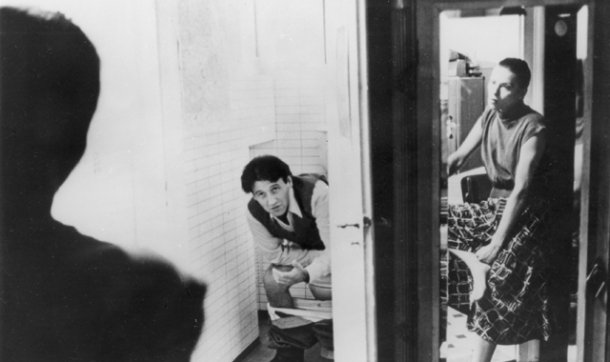
Valie Export, Invisible Adversaries, 1976. Film still.
Invisible Adversaries by Valie Export was screened and discussed by CSCA participants on 8 March 2016. Described by the Austrian artist as ‘psychic science fiction,’ and premiered in 1976, Invisible Adversaries was Export’s first feature length film [1]. Export had adopted the name of a cigarette brand to launch her career as a feminist actionist and performance artist in the 1960s. Working with the body as principle point of reference, Export linked it to new technologies and media – in their alliance with capitalism – from the outset of her practice. In Invisible Adversaries, human matter and desire are negotiated through the lens of film and photography. Marked by the triumph of live TV in private households and new aesthetic imaginaries prompted by space travel, it is unsettled politics of representation that come to prominence in Export’s 1970s.

Valie Export, Invisible Adversaries, 1976. Film still.
The film opens with news of the invasion of the Hyksos – invisible aliens that have allegedly come to seize control of human consciousness and lead to the self-destruction of civilisation on Earth. The female protagonist Anna, a photographer in Vienna, seeks evidence of these colonisers. Does the incessant stream of violent incidents shown on the news attest to their advent? Or have the Hyksos already occupied the mind of Peter, Anna’s partner, who appears to reinforce oppressively gendered roles in their relationship? More intimately still, Anna fears that her own mind and body may be steered by some remote control. Her camera captures ever more fractious subjects while disturbing dreams and visions disrupt her daily life. We see her switch from the act of the housewife frying eggs for a demanding lover, to living an emancipated and creative professional life, then a schizophrenic patient on the couch of a condescending psychiatrist. In between, the film zaps to news of the Cold War and resurging xenophobia in Austria, and then to a fashion shoot overlaid with canonical depictions of the Madonna. Suddenly a newborn appears in Anna’s fridge. Within this universe of images that pervade her ‘like psychic meteorites,’ it becomes increasingly difficult for the photographer to maintain a stable reality and identity.
CSCA participants likewise found themselves challenged by Export’s rhythmic montage of disparate imagery, relentlessly picking up in speed throughout the film. Attendees agreed that the visual richness of Invisible Adversaries makes it a thoroughly compelling work to watch – even though some felt its atmosphere of oppression to become almost unbearable. The film’s affective force may lie in the double function of what one CSCA participant called Export’s ‘cutting imagery’. Slices in the filmic and photographic material parallel incisions on bodily and organic matter in the plot. In one scene, Anna cuts her pubic hair to make a moustache of it. This is particularly telling of Export’s preoccupation with the visual coding of gender within patriarchy and her subversive play on stereotypes, allowing for Invisible Adversaries to be punctured also with moments of comic relief. As another discussant observed, Export further orchestrates insidious methods of warfare to constantly operate on multiple levels: conflicts in the domestic, national, international and extra-terrestrial sphere even, are cleverly interwoven to resonate within and across each other.

Valie Export, Invisible Adversaries, 1976. Film still.
Whilst in Valie Export’s science fiction film boundaries between the real and the imaginary collapse, CSCA comments repeatedly emphasised how the artist roots her work in palpable flesh, timely affairs, and the recognisable architecture of Vienna. Immaterial and invisible agents here do not render the tangible world on earth superfluous. Rather, they appear as the ‘enemy within’ that introduces a split, a dissident double in the image of the self-contained human. If this ideal is irrevocably lost, as Invisible Adversaries suggests – then Export at once upholds that strategies of splitting and doubling must be consciously appropriated to test, and alter ourselves and surroundings in times of advanced capitalism and image production.
Meret Kaufmann
Notes:
[1] Valie Export and Museum Moderner Kunst, Mumok, Valie Export: Split, Reality (Vienna: Springer, 1997), 133. The film was first shown at Internationale Filmfestspiele Berlin, Forum des internationalien jungen Film. It was written and directed by Valie Export in collaboration with Peter Weibel, himself an acclaimed media artist and theorist.